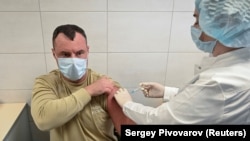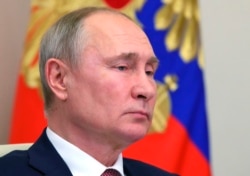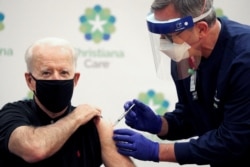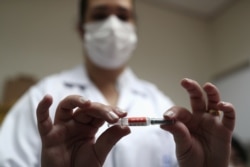On January 13, Russian President Vladimir Putin ordered a nationwide inoculation against COVID-19 with the Russian-manufactured Sputnik V vaccine.
He claimed that Sputnik V (Gam-COVID-Vac) provides the best protection and safety compared to any other coronavirus vaccine worldwide.
"The Russian vaccine — it is now completely obvious, and now the actual application shows that it is, overall the best one worldwide," Putin said.
"No other preparations of a similar kind demonstrate such a level of protection and such a degree of safety.”
Putin’s claims are unsubstantiated.
There is as yet no evidence that Sputnik V provides better protection and safety than other vaccines against SARS-CoV-2, the virus that caused the COVID-19 pandemic, which killed nearly 2 million people within a single year.
In a regular drug approval process, the scientific evaluation and assessment of its efficacy, safety, potential flaws and side effects can take years.
With the pandemic death toll rising, the World Health Organization allowed manufacturers to accelerate the study and assessment stage and expedite vaccine rollouts right after final clinical trials. Putin’s claim cannot be verified because long-term data is not available.
Some two dozen countries began vaccinations in mid-December, and more than 32 million people globally received doses of one of the several vaccine versions available by mid-January, according to the tracking site Our World in Data.
While Russia was the first country to approve its vaccine in August 2020, reportedly prior to completing its final clinical trial phase, mass vaccinations did not start until December.
Sputnik V is a two-shot vaccine delivered with three weeks between doses.
Sputnik V developer Gamaleya Research Institute of Epidemiology and Microbiology said that 22,714 people had volunteered for the Sputnik V clinical trial by December, and its efficacy rate was 91.4 %. (Efficacy measures the percentage of reduction in cases of disease compared to a group that did not receive a vaccine.)
Meanwhile, the vaccine developed by Moderna and the National Institute of Allergy and Infectious Diseases showed a 94.1% efficacy rate in its final phase 3 clinical study, which involved 30,000 participants. The vaccine proved 100% effective against “severe” COVID-19, Moderna said.
The BioNTech and Pfizer vaccine boasted 95% efficacy in a study involving 43,661 participants.
The Oxford/AstraZeneca vaccine AZD1222 proved to be 70.4% effective, according to the results of a peer reviewed study based on a trial of 11,636 participants. The BBC reports that figure could be “as high as 90% by tweaking the dose.”
The so-called “Oxford jab” is also cheaper and easier to store, making it better suited for global distribution.
China’s Sinovac Biotech vaccine has reported widely varying results, with efficacy rates ranging from 50.4% to 91.25% depending on the trial.
Most SARS-CoV-2 vaccines require two shots. Johnson & Johnson is set to roll out a single-shot coronavirus vaccine in March.
The company is seeking efficacy rates exceeding 90%, and phase 3 clinical trial data for the Johnson & Johnson vaccine is expected by late January.
Another selling point of vaccines is their storage temperatures. AZD1222, for example, can be stored at refrigerator temperature of 2-8°C.
The Pfizer vaccine by contrast, needs to be stored at -70°C, although Pfizer says it can be stored at 2-8°C for up to five days.
The Moderna vaccine may be stored at temperatures between -25°C and -15°C.
While the frozen version of the Sputnik V must be stored at -18°C, production of a freeze-dried version that can be stored at 2-8°C is expected to ramp up next month.
Cost is also an issue.
Sputnik V is set to sell for $10 per dose. The Johnson & Johnson vaccine is also $10 per dose, but only requires one shot. The Pfizer vaccine is sold for $19.50 per dose, while the Moderna vaccine price ranges from $25-$37 per dose.
The Sinovac Biotech vaccine has previously been administered for $60 in China. However, one Indonesian pharmaceutical firm contracted to buy the Chinese-made vaccine said it would cost $13.60 per dose.
The Oxford vaccine, by contrast, is priced at $3-4 dollars per dose.
In the U.S., the Pfizer and Moderna vaccines are initially paid for by the government and are free to U.S. citizens. The U.S. government has also signed a contract to buy up to 300 million doses from Astrazeneca to be provided at no cost to U.S. citizens.
Sputnik V is also being provided to Russian citizens free of charge. When administering the Sinovac vaccine in October 2020, local health officials in the Chinese city of Jiaxing declined to comment on whether the cost was being subsidized.
Russia’s decision to fast track the vaccine was criticized by scientists around the world. It also slowed foreign acceptance of the vaccine, with Belarus becoming the first state outside of Russia to register it on December 21, 2020.
Russian state media chalked up skepticism to “sour grapes.”
However, Russians, too, have been skeptical about Sputnik V. Polling data from December 23, 2020, showed that only 38% of responders planned on getting vaccinated, despite inoculation being free.
As of January 13, 1.5 million Russians — just over 1% of the population — had been vaccinated.
While the results of Sputnik V phase 1 and phase 2 trails have been published in the British medical journal Lancet, a comprehensive scientific paper on the larger phase 3 trial results has not been released.
The Sputnik V phase 3 trial will run until May and cover 40,000 participants.
The Gamaleya Institute described Sputnik V as “one of the top 10 vaccine candidates on the list of the World Health Organization, approaching the end of clinical trials and the beginning of mass production.”









